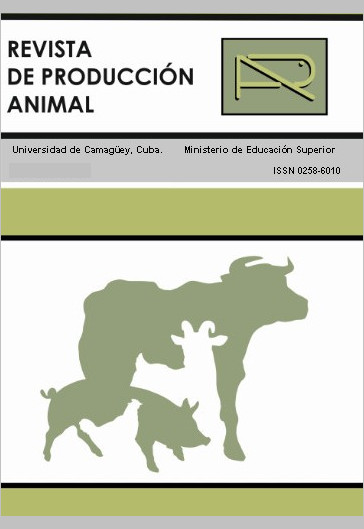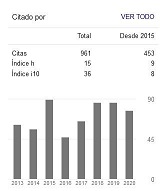Comparación entre la inseminación artificial con deposición intracornual y deposición en el cuerpo del útero en novillas Holstein-Friesian.
Resumen
Se compararon dos inseminaciones: con deposición en el cuerpo del útero y con deposición intracornual en 40 novillas Holstein-Friesian, de la provincia del Azuay, cantón Cuenca, Parroquias Cumbe y Victoria del Portete. Los animales eran mayores de 18 meses, con peso superior a los 300 kg, condición corporal de 2,5 a 3,5 y similares condiciones de manejo y sanidad. Cada tratamiento estuvo distribuido aleatoriamente en 4 bloques de 5 novillas. Se determinó por ultrasonido el cuerpo lúteo funcional. Para la sincronización de los celos se utilizó PGF2α (250 mcg d-cloprostenol). A las 48 y 72 h se presentó celo y se midió el tamaño del folículo preovulatorio. Luego se inseminó con las dos técnicas. A los 30 días se realizó el chequeo ginecológico para evaluar el por ciento de preñez, que en el tratamiento con deposición en el cuerpo del útero fue de 35 %, inferior significativamente al tratamiento con deposi-ción intracornual (70 %).
Comparison between Artificial Insemination with Intracornual and Uterine Body Deposition in Holstein-Friesian Heifers.
ABSTRACT
Two insemination types were compared: intracornual and uterine body deposition in Holstein-Friesian 40 heifers the province of Azuay, Cuanca Region, Cumbe and Victoria Portete Parishes. The animals were over 18 months old, weighing more than 300 kg; physical condition 2.5-3.5, and similar management and hygiene conditions. Each treatment was randomized in 4 blocks with 5 heifers each. Functional corpus luteum was determined by ultrasound. PGF2α (250 mcg d-cloprostenol) was used for estrus synchronization. Estrus occurred at 48 and 72 h, and the size of the pre-ovulatory follicle was measured. Then, the two techniques were used to inseminate the animals. Gynecological checkup was performed 30 days after to assess pregnancy percent. Uterine body deposition accounted for 35 %, whereas intracornual deposition was significantly higher (70 %).
Descargas
Citas
CHRENEK, P.; KUBOVICÔVÁ, E.; OLEXÍKOVÁ, L.; MAKAREVICH, V. A.; TOPORCEROVÁ, S. and OSTRÓ, A. (2014). Effect of Body Condition and Season on Yield and Quality of In Vitro Produced Bovine Embryos. Zygote. Cambridge University Press.
SPSS (2010). SPSS (ver.19). IBM company.
KARAKAYA, E.; YILMAZBAS-MECITOG, G.; KESKIN, A.; ALKAN, A.; TASDEMIR, U.; SANTOS, J.E.P. and GUMEN, A. (2014). Fertility in Dairy Cows After Artificial Insemination Using Sex-Sorted Sperm or Conventional Semen. Reprod. Dom. Anim., 49, 333-337.
KURYKIN, J.; JAAKMA, U.; MAJAS, L.; JALAKAS, M.; AIDINIK, M.; WALDMAN, N. A. y PADRIK, P. (2013). Fixed Time Deep Intracornual Insemination of Heifers at Synchronized Estrus. Theriogenology, 60, 1261-1268.
KURYKIN, J.; JAAKMA, U.; WALDMAN, N. A.; JALAKAS, M.; AIDINK, M.; MAJAS, L.; PADRIK, P. (2006). Low Semen Dose Intracornual Insemina-tion of Cows at Fixed Time after PGF2α Treatment or at Espontaneus Estrus. Animal Reproduction Science, 95, 116-124.
KURYKIN, J.; JAAKMA, U.; WALDMAN, N. A.; JALAKAS, M.; AIDINK, M.; MAJAS, L. y PADRIK, P. (2010). Pregnancy Rates in Estonian Holstein Hei-fers after Insemination with Sexed perm. Reproduction Fertility and Development, 23 (1), 112-112.
LOPEZ-GATIUS, F. (2010). Site of Semen Deposition in Cattle: a Review. Theriogenology, 53, 7, 1407-14.
MEIRELLES, C.; KOSICKI, L. E.; WEISS, R. R.; SEGUÍ, M. S.; SOUZA, A.; SANTOS, I. W. y BREDA, J. C. S. (2012). Comparison Between Deep Intracornual Artificial Insemination (DIAI) and Conventional Artificial Insemination (AI) Using low Concentration of Spermatozoa in Beef Cattle. Braz. Arch. Biol. Technol., 55 (3), 371-374.
SERRANO, J. (2009). Uso semen sexado. Extraído en 2014, desde http://jairoserrano.com/2009/02/usando-semen-sexado.
SILVEIRA, E. C.; BORTOLLOTI, L. A.; MOROTTI, F.; SILVA-SANTOS, K. C.; SANTOS, G. M. G. et al. (2013). Insemination of Four Cows per Dose of Frozen Semen with a Fixed-Time Artificial Inse-mination Protocol. Anim. Reprod., 10 (2), 124-126.
VERBERCKMOES, S.; VAN SCOOM, A.; DE PAUW, I.; DEWULF, J. et al. (2004). Assessment of a New Utero-Tubal Junction Insemination Device in Dairy Cattle. Theriogenology, 61, 103-115.
Los autores de los artículos publicados en RPA retienen los derechos de autor de su trabajo, de marca y patente, y también sobre cualquier proceso o procedimiento descrito en el artículo, así como a compartir, copiar, distribuir, ejecutar y comunicar públicamente el artículo publicado en la RPA o cualquier parte de aquel siempre que indiquen la fuente de publicación (autores del trabajo, revista, volumen, número y fecha), pero están de acuerdo en que la revista publique los trabajos bajo una licencia Creative Commons.
![]() Licencia Attribution-NonCommercial 4.0 International (CC BY-NC 4.0)
Licencia Attribution-NonCommercial 4.0 International (CC BY-NC 4.0)






































